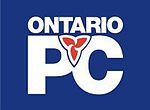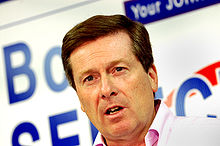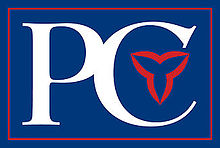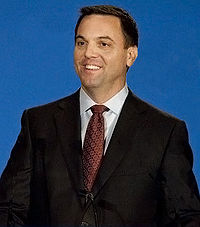- Progressive Conservative Party of Ontario
-
Progressive Conservative Party of Ontario
Parti progressiste-conservateur de l'Ontario
Active provincial partyLeader Tim Hudak President Ken Zeise Founded 1854 Headquarters 401-19 Duncan Street, Toronto, Ontario
M5H 3H1Ideology Conservatism
Progressive conservatismPolitical position Centre-right to Right-wing Official colours Blue Seats in Legislature 37 / 107Website www.ontariopc.com Politics of Ontario
Political parties
ElectionsThe Progressive Conservative Party of Ontario (in French: Parti progressiste-conservateur de l'Ontario), is a right-of-centre political party in Ontario, Canada. The party was known for many years as "Ontario's natural governing party." It has ruled the province for 80 of the 144 years since Confederation, including an uninterrupted run from 1943 to 1985. It currently forms the Official Opposition in the Legislative Assembly of Ontario.
History
Origins
The first Conservative Party in Upper Canada was made up of United Empire Loyalists and supporters of the wealthy Family Compact that ruled the colony. Once responsible government was granted in response to the 1837 Rebellions, the Tories emerged as moderate reformers who opposed the radical policies of the Reformers and then the Clear Grits.
The modern Conservative Party originated in the Liberal-Conservative coalition founded by Sir John A. Macdonald and George-Étienne Cartier in 1854. It is a variant of this coalition that formed the first government in Ontario with John Sandfield Macdonald as Premier. Sandfield Macdonald was actually a Liberal and sat concurrently as a Liberal Party of Canada MP in the Canadian House of Commons but he was an ally of John A. Macdonald. His government was initially a true coalition of Liberals and Conservatives under his leadership but soon the more radical Reformers bolted to the opposition and Sandfield Macdonald was left leading what was essentially a Conservative coalition that included some Liberals under the Liberal-Conservative banner. After losing power in 1871, this Conservative coalition began to dissolve. What was originally a party that included Catholics and Protestants became an almost exclusively English and Protestant party, more and more dependent on the Protestant Orange Order for support, and even for its leadership. The party became opposed to funding for separate (Catholic) schools, opposed to language rights for French-Canadians, and distrustful of immigrants. Paradoxically, an element of the party gained a reputation for being pro-labour as a result of links between the Orange Order and the labour movement.
Until becoming the Progressive Conservatives in 1942, the party was officially known as the Liberal-Conservative Association of Ontario, reflecting its Liberal-Conservative origins, but became widely known as the Conservative Party.
Pre-war dynasty
After 33 years in Opposition, the Tories returned to power under James P. Whitney, who led a progressive administration in its development of the province. The Whitney government initiated massive public works projects such as the creation of Ontario Hydro. It also enacted reactionary legislation (such as Regulation 17) against the French-Canadian population in Ontario. The Tories were in power for all but five years from 1905 to 1934. After the death of Whitney in 1914, however, they lacked vision and became complacent. The Tories lost power to the United Farmers of Ontario in the 1919 election but were able to regain office in 1923 election due to the UFO's disintegration and divisions in the Ontario Liberal Party. They were defeated by Mitch Hepburn's Liberals in 1934 due to their inability to cope with the Great Depression.
Post-war dynasty
Late in the 1930s and early in the 1940s, the Conservatives re-organized and developed new policies. Rather than continue to oppose government spending and intervention, a policy which hurt the party politically in the time of the Great Depression, the Conservatives changed their policies to support government action where it would lead to economic growth. It was at this time that the party changed its name to the "Progressive Conservative" party to reflect this change. Seeing that the country could afford the war-time spending levels, meant that governments could afford to spend to support economic growth.[citation needed]
The Conservatives took advantage of Liberal infighting to win a minority government in the 1943 provincial election, reducing the Liberals to third-party status. Drew called another election in 1945, only two years into his mandate, to get a majority government. The Tories played up Cold War tensions to win a landslide majority, though it emerged several years later that the Tory government had set up a secret department of the Ontario Provincial Police to spy on the opposition and the media. The party would dominate Ontario politics for the next four decades.
The anti-Catholic, anti-French, anti-immigrant strain of the Tories was evident under Drew and his successor, Leslie Frost, who embodied all those elements. In 1961, John Robarts became the 17th premier of Ontario. He was one of the most popular premiers in years. Under Robarts' lead, the party epitomized power. He was an advocate of individual freedoms and promoted the rights of the provinces against what he saw as the centralizing initiatives of the federal government, while also promoting national unity against Quebec separatism. He hosted the 1967 "Confederation of Tomorrow" conference in Toronto in an unsuccessful attempt to achieve an agreement for a new Constitution of Canada.
Robarts initially opposed Canadian medicare when it was proposed, but later endorsed it fully. He led the party towards a civil libertarian movement. As a strong believer in the promotion of both official languages, he opened the door to French education in Ontario schools.
Big Blue Machine era
In 1971, Bill Davis became party leader and the 18th premier. Anti-Catholicism became an issue again in the 1971 election, when the Tories under campaigned strenuously against a Liberal proposal to extend funding for Catholic separate schools until Grade 13. Davis reversed himself in 1985, and enacted the funding extension as one of his last acts before leaving office.
Davis governed until 1985 with a team of advisers known as the "Big Blue Machine" because of their reputed political and strategic skills. Their stamp on the party was so strong that many refer to the Tories' long rule over Ontario as the "Big Blue Machine era."
During Davis's time as leader of the PC Party, the party moved to the centre, and on some issues, moved to the left of the Liberals. However, its base of support remained with socially conservative voters in rural central Ontario. This made him one of the most popular politicians in Ontario's history. Other conservatives in the federal PC Party accused him of damaging the conservative image in Canada by moving to the left on some issues.
1980s to 1995: in Opposition
Party logo in 1985 Party logo in 1987
Party logo in 1987 Party logo in 1990
Party logo in 1990
Davis retired in 1985. At a leadership convention, he was succeeded by Industry and Trade Minister Frank Miller. Miller was considerably more conservative than Davis, and began shifting the party back to the right. Soon after taking office, he called an election in which the Conservatives were reduced to a minority government, and actually finished behind the Liberals in the popular vote for the first time in 42 years.
Soon afterward, the Ontario New Democratic Party of Bob Rae reached an agreement with David Peterson's Liberals in which the NDP would support a Liberal minority government. Miller was defeated in a no-confidence motion on June 18. Peterson was asked to form a government later in the day, ending the longest period of one-party rule in Canadian provincial history. Miller was replaced as leader by Larry Grossman at a second leadership convention.
When the Liberal-NDP Accord expired, an election was held in 1987 in which the Tories were reduced to third place in the Legislative Assembly of Ontario. Grossman was personally defeated in his downtown Toronto riding and resigned immediately. Andy Brandt was the party's interim leader until a leadership election was held in 1990 in which Mike Harris defeated Dianne Cunningham.
The Tories failed to improve their standing in the 1990 election under Harris, in which Peterson was defeated by Rae's NDP.
Mike Harris and the "Common Sense Revolution"
In the 1995 election, Harris catapulted his party from third place to an election victory, running on a neoliberal platform known as the "Common Sense Revolution" that highlighted a number of "wedge issues" and promised significant tax cuts, cuts to welfare, the introduction of workfare, and privatization of social services. Harris went on to win a second majority in 1999 despite the strikes and protests that plagued his first term in office.
The Harris government was criticized on issues such as health care, the environment, education, and its tax policies, though it remained generally popular until Harris's departure as party leader.
The slide in Conservative support began in early 2000, according to the Ipsos-Reid polling company (Ipsos-Reid website), when the Tories fell behind the Liberals in the public opinion polls for the first time since the 1999 election, with 36% support of those polled, compared to 42% for the Liberals and 17% for the NDP. Later in 2000, Liberal support rose to about half of those polled, while Conservative support remained in the low 30s. This pattern held through to the 2002 leadership campaign, when Conservative support rose to 37%, while the Liberals retained the support of about half of those polled.
See also: double cohortErnie Eves: distancing the party from the "Common Sense Revolution"
With the resignation of Mike Harris in 2002, the PCs held a leadership election. Ernie Eves, who had been Harris' Minister of Finance, and who had the backing of almost all PC MPPs, won the campaign, defeating his successor as Minister of Finance, Jim Flaherty.
Eves was a Red Tory, unlike Harris. He'd tried to blunt some of the edges of the more radical elements of Harris' platform while in Cabinet. His rejection of the "Common Sense Revolution" continued after he became premier. He killed plans to sell off Hydro One when deregulation of energy prices resulted in a dramatic increase in energy rates and threatened a consumer revolt. This led him to re-impose retail price controls on electricity, capping the price at 4.3 cents per kilowatt/hour, and vowing to keep it capped until at least 2006. The result was a quickly escalating public debt that made up for shortfalls in the price of electricity.
 Ontario PC logo, 2003 to 2006
Ontario PC logo, 2003 to 2006
During the summer after Eves’ election as leader, the Conservatives closed the gap in popular support considerably, placing only two percentage points behind the Liberals in two summer public opinion polls. By the autumn of 2002, however, Eves’ ‘honeymoon’ with the voters was over, and the party fell back in the polls, hovering in the mid-to-high 30s, while the Liberals scored in the mid-to-high 40s.
2003 election defeat
Despite his attempt to recast the Tory government as a moderate one, Eves was unable to reverse the slide in the polls the Tories had suffered in the last years of Harris' tenure.
Eves asked Flaherty's campaign chairman, Jaime Watt, to co-manage the Conservative election campaign, along with the rest of the "Whiz Kids" team that had previously worked for Harris. Only Tom Long, the central organizer in Harris' campaigns, refused to work for Eves.
The "Whiz Kids" reputation for competence was marred by publicity stunts such as handing down his government's second budget at the headquarters of Magna International instead of in the provincial legislature. Voter backlash against this break with parliamentary tradition forced the delay of a planned spring election in 2003.
In May 2003, Eves released the party's platform, "The Road Ahead". The document promoted an aggressive hard-right agenda, and was closer in spirit to Harris and Flaherty's agenda than to Eves' own. In releasing this document, Eves reversed his earlier positions on banning teacher's strikes, jailing the homeless, private school tax credits and same-sex marriage. The platform also called for mortgage interest deductibility.
The Conservative election campaign was riddled with mistakes and miscues, and Eves appeared very uncomfortable trying to sell a platform he had opposed only a year earlier. In contrast, the Liberals had spent the last four years positioning themselves as the government in waiting, and ran on the simple platform of "Choose Change". Conservative television ads which attacked Liberal leader Dalton McGuinty as "still not up to the job" were received poorly by the voting public, and allowed the Liberal campaign to portray the Tories as needlessly confrontational.
A critical point in the campaign was when members of the Eves team jokingly referred to McGuinty as an "evil reptilian kitten-eater from another planet", a comment that made the Conservatives appear desperate to vilify their opponents. In the final days leading up to the vote, Eves was further criticized for saying that McGuinty just says "whatever comes into his pointy little head". On election day, the Conservatives were routed, falling to 24 seats.
John Tory's Tories (2004 to 2009)
In early 2004, Eves announced his intention to step down as leader. A leadership convention to replace him was called for the fall.
Jim Flaherty was the first to enter the race, campaigning on the same right wing platform as in 2002. He was soon opposed by John Tory, a former executive with Rogers Cable and a Toronto mayoral candidate in 2003, sometimes viewed as a Red Tory due to his association to former Ontario Premier Bill Davis. Member of Provincial Parliament Frank Klees, the third candidate in the race, was a supporter of the Common Sense Revolution and campaigned for a parallel private health care system.
The 2004 leadership election was held on September 18, 2004, electing John Tory as the party's new leader. Tory, a longtime backroom player in the PC Party, was elected to the Ontario legislature in a by-election in March, 2005, in the seat that Eves held.[1]
In polling prior to the 2007 general election, the PCs' support rose after the first Liberal budget in 2004. The party was virtually tied with the Liberals, as Tory has experimented with several different orientations. During his first year as leader, Tory attempted to rise above partisan politics, openly contemptuous of partisan moves and pledging to improve decorum in the legislature. In his second year as leader, Tory adopted a more traditional approach to the issues, sharply opposing the Liberal plans on taxes, spending, deficits and cuts. Heading into the election year, Tory put most of his emphasis on criticizing the government's handling of a standoff with Iroquois aboriginals in Caledonia in order to portray the government as weak. He also emphasized traditional right-wing issues like taxes, crime and government spending.
During the 2006 PC Policy Convention, Tory introduced his plan for shaping up the PCs' platform for the 2007 election campaign. His ideas were stated in what have been called "The White Papers".[2]
The party experienced a drop in popularity, however, after Tory pledged to provide government funding for faith-based schools. The proposal, which proved to be unpopular with voters,[3] contributed largely to the party's loss. The Liberals won a second majority government, and the PCs made and negligible gains in the legislature (one more seat, but a 3 per cent drop in the popular vote). Tory, who had left his Dufferin—Peel—Wellington—Grey seat to run in Don Valley West, would lose to Liberal incumbent Kathleen Wynne.
2008 party convention and the leadership review question
As a result of the election loss, the party decided to hold a leadership review vote at its 2008 General Party Meeting in London.[4] The Ontario PC Party's constitution requires that the Party hold a leadership review vote at the first party convention after an election defeat.[4]
From the election day until the 2008 General Meeting, party members were divided into two "camps": those who supported John Tory's position as Party Leader and those who opposed his leadership. Several campaigns to oust John Tory as leader of the party, most notably by a party activist group led by former party president Rueben Devlin called Grassroots PC.[5][6] John Tory had the public support of the PC legislative caucus, and most notably, support from former premiers and predecessors Ernie Eves and Bill Davis.[7]
The lead-up to the review vote was marked by high emotions on both sides of the debate and allegations of rule breaking. Such allegations were risen when caucus members sent letters on party letterhead seeking support for Tory. The letters signed by Tory MPPs Bob Runciman and Toby Barrett were a clear violation of the rules of the party, as the party in general is supposed to be neutral on the leadership review question.[8] Tory responded by stating that he and his supporters will reimburse the party for the letters that the caucus members had sent in support of Tory's position as leaders. As a result, the party's president, Blair McCreadie, had stated that the matter is closed.[8] A supporter of Mr. Tory's, PC Youth President Andrew Brander, launched a series of last-minute challenges of delegates on the grounds that they are representing ridings where they neither live nor work.[9]
Tory received 66.9% support, lower than internal tracking which showed him more comfortably in the 70 per cent range - appeared to come as a shock to Tory.[7][10] The percentage of support received by Tory was nearly identical to Joe Clark's 1983 support when he was federal PC leader, which resulted in Clark resigning as leader, and is often seen as the benchmark for Canadian party leaders to get to stay on as leader.[11]
Three hours after the leadership review vote, John Tory announced to the delegates at the Ontario PC's general meeting that he would stay on as leader of the Party.[12] Tory came under heavy criticism from several party members following this delay, with his opponents signalling that they would continue to call for an end to what they called his 'weak' leadership.[13] Other party members, such as former Mike Harris chief of staff Guy Giorno and interim Leader of the Opposition Bob Runciman, supported John Tory, saying that his opponents should accept the results and move on.[12][13]
2009 leadership election
Main article: Progressive Conservative Party of Ontario leadership election, 2009John Tory announced his pending resignation as leader the day following his defeat in a by-election. On June 27, 2009 party members elected Tim Hudak as the party's new leader. Christine Elliott, Frank Klees, and Randy Hillier were the unsuccessful candidates.
Current leadership and Members of Provincial Parliament
Party leadership Name Position Tim Hudak Party Leader Ken Zeise Party President Members of Provincial Parliament Name Riding Position Tim Hudak Niagara West-Glanbrook Leader of the Opposition Christine Elliott Whitby-Oshawa Deputy Leader
Health and Long-Term Care CriticTed Arnott Wellington-Halton Hills Aboriginal Affairs Critic
Culture Critic
Deputy Opposition House Leader
TourismRobert Bailey Sarnia-Lambton Training and Apprenticeship Critic Toby Barrett Haldimand-Norfolk Caucus Chair
Environment CriticTed Chudleigh Halton Deputy Whip
Attorney General CriticGarfield Dunlop Simcoe North Community Safety and Correctional Services Critic Ernie Hardeman Oxford Agriculture, Food and Rural Affairs Critic Randy Hillier Lanark-Frontenac-Lennox and Addington Labour Critic
Northern Development, Mines and Forestry CriticSylvia Jones Dufferin-Caledon Children and Youth Services Critic
Community and Social Services CriticFrank Klees Newmarket-Aurora Public Infrastructure Critic
Transportation CriticLisa MacLeod Nepean-Carleton Revenue and Government Accountability Critic Gerry Martiniuk Cambridge Health Promotion Critic
Seniors’ Secretariat CriticNorm Miller Parry Sound-Muskoka Chief Whip
Finance CriticJulia Munro York North Consumer Services, Small Business and Red Tape Critic Bill Murdoch Bruce—Grey—Owen Sound Municipal Affairs and Housing (Rural and Northern) Critic John O'Toole Durham Deputy Whip
Government Services CriticJerry Ouellette Oshawa Natural Resources Critic Jane McKenna Burlington Critic of Children and Youth Services and Deputy Co Chair of Ethnic Outreach Peter Shurman Thornhill Economic Development and Trade Critic
Francophone Affairs CriticNorm Sterling Carleton-Mississippi Mills Intergovernmental Affairs Critic Jim Wilson Simcoe-Grey Research and Innovation Critic
Colleges and Universities CriticElizabeth Witmer Kitchener-Waterloo Education Critic
Women’s Directorate CriticJohn Yakabuski Renfrew-Nipissing-Pembroke House Leader
Energy CriticSteve Clark Leeds-Greenville Citizenship and Immigration
Democratic ReformParty leaders
Conservative Party of Canada West (pre-Confederation)
Leader Years in office 1 Sir John A. Macdonald 1854–1867 2 John Sandfield Macdonald[14] 1862–1864 Liberal-Conservative Association of Ontario
Leader Years in office con't John Sandfield Macdonald 1867–1871 3 Matthew Crooks Cameron 1871–1878 4 William Ralph Meredith 1879–1894 5 George Frederick Marter 1894–1896 6 Sir James P. Whitney 1896–1914 7 Sir William Hearst 1914–1919 8 George Howard Ferguson 1919–1930 9 George Stewart Henry 1930–1936 10 William Earl Rowe 1936–1938 11 George Drew 1938–1942 Progressive Conservative Party of Ontario
Leader Years in office con't George Drew 1942–1948 12 Thomas Kennedy 1948-1949 (interim) 13 Leslie Frost 1949–1961 14 John Robarts 1961–1971 15 William (Bill) Davis 1971–1985 16 Frank Miller 1985–1986 17 Larry Grossman 1986–1987 18 Andy Brandt 1987-1990 (interim) 19 Mike Harris 1990–2002 20 Ernie Eves 2002–2004 21 John Tory 2004–2009 22 Bob Runciman 2009 (interim) 23 Tim Hudak 2009–present Recent election results
Election Seats won Seats available Popular vote Popular vote (%) Legislative role Party leader 1985[15] 52 125 1,343,044 37.0% Official opposition
Initially in GovernmentFrank Miller 1987 16 130 931,473 24.7% Third party Larry Grossman 1990 20 130 944,564 23.5% Mike Harris 1995 82 129 1,870,110 44.8% Majority
GovernmentMike Harris 1999 59 103 1,978,059 45.1% Mike Harris 2003 24 103 1,559,181 34.7% Official opposition Ernie Eves 2007 26 107 1,398,857 31.64% John Tory References and footnotes
- ^ John Tory's Biography on the Ontario PC Official Website
- ^ Ontario PC - Party Whitepapers
- ^ CBC.ca - McGuinty wins massive majority, Tory loses seat
- ^ a b "Will provincial leaders stay, or go?" — Toronto Star/TheStar.com (October 15, 2007)
- ^ GrassrootsPC.ca
- ^ "Decision won't sit well with Tory's detractors" — London Free Press (February 24, 2008)
- ^ a b "Tory to remain leader of Ontario PCs despite lukewarm vote" — Globe and Mail (February 23, 2008)
- ^ a b "Controversy dogs Ontario PC leadership review" — Globe and Mail (February 23, 2008)
- ^ "Ontario's Tory hopes party will forgive and forget" — Globe and Mail (February 22, 2008)
- ^ TheStar.com | Ontario | Tory to remain as PC leader
- ^ "'Time to move on' after divisive leadership vote: Conservative Leader John Tory" — Canadian Press (February 24, 2008)
- ^ a b "Conservative Leader John Tory to remain after 67 per cent in leadership vote" — Canadian Press (February 23, 2008)
- ^ a b "Critics assail 'weak' Tory" — National Post (February 24, 2008)
- ^ Shared role with Sir John A. Macdonald as joint premiers of the Province of Canada representing Canada West (Ontario).
- ^ Won most seats in 1985 election, but lost power after Liberals signed a pact with the NDP to form the government.
See also
- Progressive Conservative Party candidates, 2011 Ontario provincial election
- List of Ontario general elections
- List of Premiers of Ontario
- List of Leaders of the Opposition in Ontario
- List of political parties in Canada
- Ontario PC Youth Association
External links
Provincial political parties in Ontario 
Legislative Assembly Other parties recognized by Elections Ontario Historical parties represented in the legislature Co-operative Commonwealth Federation · Labour (Independent) · Labor-Progressive · Liberal-Labour · Liberal-Progressive · Patrons of Industry · Soldier · Protestant Protective Association · United FarmersPre-confederation parties Conservative and right-of-centre parties in Canada Forming the government Forming the official opposition Third Parties with representation No representation in the Commons No representation in legislature British Columbia Conservatives - Family Coalition (Ontario) - Saskatchewan PCs - Social Credit (Alberta) - Social Credit (British Columbia) - Reform (Ontario)Historical national parties Historical provincial and territorial parties Alberta Alliance - Quebec Conservatives - New Brunswick Confederation of Regions Party - Northwest Territories Liberal-Conservatives - Ralliement créditiste du Québec - Union Nationale - Yukon Progressive Conservative Party
Conservative (1873-1942) Progressive Conservative (1942-present) Politics of Ontario Crown in Ontario Elizabeth II
Lieutenant Governor Premier Opposition Leader Speaker of the Assembly Legislature Political parties Elections Current issues Other Canadian politics Categories:- 1854 establishments in Canada
- Organizations based in Toronto
- Political parties established in 1854
- Progressive Conservative Party of Ontario
- Provincial political parties in Ontario
Wikimedia Foundation. 2010.





